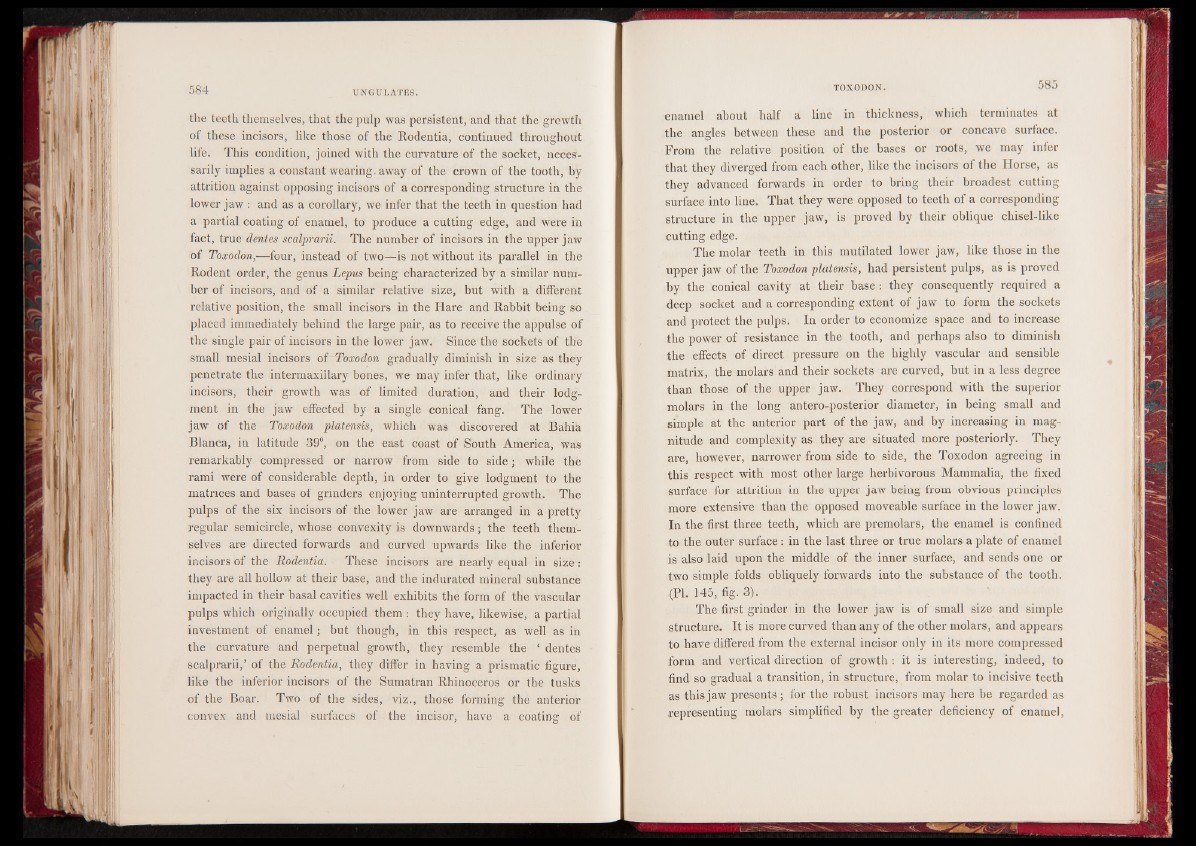
the teeth themselves, that the pulp was persistent, and that the growth
of these incisors, like those of the Rodentia, continued throughout
life. This condition, joined with the curvature of the socket, necessarily
implies a constant wearing, away of the crown of the tooth, by
attrition against opposing incisors of a corresponding structure in the
lower jaw : and as a corollary, we infer that the teeth in question had
a partial coating of enamel, to produce a cutting edge, and were in
fact, true dentes scalprarii. The number of incisors in the upper jaw
of Toxodon,—four, instead of two—is not without its parallel in the
Rodent order, the genus Lepus being characterized by a similar number
of incisors, and of a similar relative size, but with a different
relative position, the small incisors in the Hare and Rabbit being so
placed immediately behind the large pair, as to receive the appulse of
the single pair of incisors in the lower jaw. Since the sockets of the
small mesial incisors of Toxodon gradually diminish in size as they
penetrate the intermaxillary bones, we may infer that, like ordinary
incisors, their growth was of limited duration, and their lodgment
in the jaw effected by a single conical fang. The lower
jaw of the Toxodon platensis, which was discovered at Bahia
Blanca, in latitude 39°, on the east coast of South America, was
remarkably compressed or narrow from side to side; while the
rami were of considerable depth, in order to give lodgment to the
matrices and bases of grinders enjoying uninterrupted growth. The
pulps of the six incisors of the lower jaw are arranged in a pretty
regular semicircle, whose convexity is downwards; the teeth themselves
are directed forwards and curved upwards like the inferior
incisors of the Rodentia. These incisors are nearly equal in size:
they are all hollow at their base, and the indurated mineral substance
impacted in their basal cavities well exhibits the form of the vascular
pulps which originally occupied them : they have, likewise, a partial
investment of enamel; but though, in this respect, as well as in
the curvature and perpetual growth, they resemble the ‘ dentes
scalprarii,’ of the Rodentia, they differ in having a prismatic figure,
like the inferior incisors of the Sumatran Rhinoceros or the tusks
of the Boar. Two of the sides, viz., those forming the anterior
convex and mesial surfaces of the incisor, have a coating of
enamel about half a line in thickness, which terminates at
the angles between these and the posterior or concave surface.
From the relative position of the bases or roots, we may infer
that they diverged from each other, like the incisors of the Horse, as
they advanced forwards in order to bring their broadest cutting
surface into line. That they were opposed to teeth of a corresponding
structure in the upper jaw, is proved by their oblique chisel-like
cutting edge.
The molar teeth in this mutilated lower jaw, like those in the
upper jaw of the Toxodon platensis, had persistent pulps, as is proved
by the conical cavity at their base : they consequently required a
deep socket and a corresponding extent of jaw to form the sockets
and protect the pulps. In order to economize space and to increase
the power of resistance in the tooth, and perhaps also to diminish
the effects of direct pressure on the highly vascular and sensible
matrix, the molars and their sockets are curved, but in a less degree
than those of the upper jaw. They correspond with the superior
molars in the long antero-posterior diameter, in being small and
simple at the anterior part of the jaw, and by increasing in magnitude
and complexity as they are situated more posteriorly. They
are, however, narrower from side to side, the Toxodon agreeing in
this respect with most other large herbivorous Mammalia, the fixed
surface for attrition in the upper jaw being from obvious principles
more extensive than the opposed moveable surface in the lower jaw.
In the first three teeth, which are premolars, the enamel is confined
to the outer surface : in the last three or true molars a plate of enamel
is also laid upon the middle of the inner surface, and sends one or
two simple folds obliquely forwards into the substance of the tooth.
(PL 145, fig. 3).
The first grinder in the lower jaw is of small size and simple
structure. It is more curved than any of the other molars, and appears
to have differed from the external incisor only in its more compressed
form and vertical direction of growth : it is interesting, indeed, to
find so gradual a transition, in structure, from molar to incisive teeth
as this jaw presents ; for the robust incisors may here be regarded as
representing molars simplified by the greater deficiency of enamel,